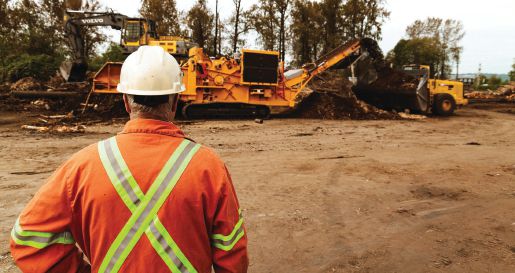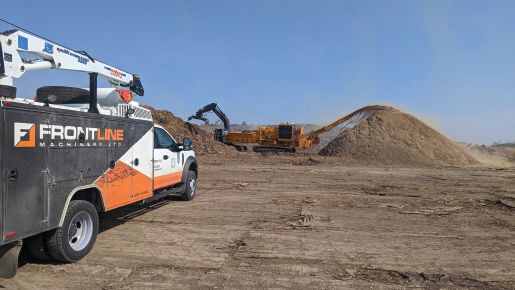Maximizing Efficiency and Longevity
Exploring maintenance and operation strategies for grinders and chippers
By John Pauley (CBI) and Mathew Porter (Frontline Machinery)
Published by Canadian Biomass Magazine
Chippers and grinders are essential assets in industries focused on wood processing and waste management. Achieving optimal operation and extending the lifespan of these hefty machines requires a multifaceted approach encompassing operational insights, technological advancements, meticulous maintenance protocols, and real-world applications.
1. UNDERSTANDING OPERATIONAL OVERSIGHTS AND TRAINING
Common mistakes and solutions: Operators often face challenges stemming from improper machine parameter settings. Experts in the field emphasize the importance of recognizing and steering clear of manual adjustments. Instead, fine-tuning parameters or tip configurations is crucial for achieving peak efficiency.
Contrary to intuition, operators’ tendencies to cram excessive material into the feeder does not translate to heightened processing capacity. Instead, it often reduces productivity and accelerates wear on the machine’s components. “It’s not just about tossing in the material; it’s about understanding the machine’s limits and working with them,” says Mathew Porter, service technician of Frontline Machinery. “A well-trained operator knows the importance of a steady and controlled feed and pre-processing material into manageable chunks. Too much, too fast and too big, you risk throwing the whole performance off balance, causing unnecessary strain on the grinder.”
The role of operator training: Comprehensive training for operators is crucial. When operators fully understand the fundamentals of the controls and feeding parameters, they can make the machine work its best without causing damage.
Strategic operational insights: Besides avoiding common oversights, strategic operational insights can significantly impact efficiency. Understanding the ideal material feed rates, material sizing, adjusting cutter settings for different materials and optimizing blade angles are additional tactics that operators can employ.
Continuous learning and improvement culture: Encouraging a learning and improvement culture among operators through training sessions and workshops can improve skill sets and keep them informed on advancements. “Partnering with a dealer who can support in providing operator training will help producers unlock the potential of their machine,” says Porter. “As someone who provides training on CBI equipment, I believe the secret to mastering these beasts is making sure our operators really get the hang of things.”
2. TECHNOLOGICAL INNOVATIONS IN MAINTENANCE
Advancements and their impact: Recent technological innovations in chipper/grinder design have revolutionized maintenance practices. Integrating remote grease lines in the discharge section streamlines access to critical greasing points. Furthermore, introducing Continental Biomass Industries’ (CBI’s) intelligent infeed systems and single bolt tips without nuts enhances efficiency and expedites tip replacements.
The CBI Intelligrind system represents a variable speed infeed system designed to optimize the material throughput in grinders. Its primary function revolves around minimizing the interruptions in the infeed system. By reducing or eliminating the frequent stops and starts in the infeed process, Intelligrind aims to streamline the material processing workflow.
It’s advisable to keep Intelligrind disabled until operators comprehensively understand its functionalities. This cautious approach allows operators to familiarize themselves with the system’s intricacies, ensuring that once enabled, Intelligrind is used optimally to achieve maximum material throughput without compromising the machine’s operational efficiency.
Some modern chipper/grinder models are equipped with remote monitoring and diagnostic tools. These features enable real-time monitoring of machine performance, predictive maintenance scheduling, and troubleshooting.
“With CBI’s T-link remote monitoring tool, we can help troubleshoot issues even when we aren’t on site,” says Porter. “Codes and diagnostic reports on the machine showing operating temperatures, pressures, machine, engine loads, and more are available at our fingertips.”
4. FUNDAMENTAL MAINTENANCE PROCEDURES
Sustaining peak performance: A robust maintenance regimen is the cornerstone of machine longevity. Adhering diligently to greasing schedules and comprehensive daily checklists ensures fluid levels, filters, belt tracking and debris clearance are consistently managed. Proactively identifying and swiftly resolving issues during routine inspections helps to mitigate downtime and prevent potential breakdowns. Removing debris, grease and other flammable material ultimately extends the machine’s lifespan.
Predictive maintenance practices: Implementing predictive maintenance practices, such as vibration analysis, thermal imaging, and oil analysis, can forecast potential issues before they escalate.
5. WEATHER CONDITIONS AND MACHINE RESILIENCE
Adapting to varied environments: While CBI machines boast adaptability, extreme weather can challenge any machine. Proper preparation and adherence to maintenance schedules are critical to fortify machines against harsh conditions. Thoroughly preparing machines to withstand specific environmental challenges they may encounter ensures sustained productivity.
Weather-proofing measures: Investing in weather-proofing measures, such as enclosures or shelters for machines operating in extreme weather conditions, can shield them from adverse effects and help maintain operational efficiency.
In extremely cold temperatures, preheating the grinder’s engine and hydraulics is crucial to prevent fluid thickening and ensure smooth functionality. Cold-weather lubricants should be used, and fuel additives can help prevent gelling. Operators should be attentive to the potential freezing of water lines and take measures to insulate or heat them.
6. OPTIMIZING TIP MAINTENANCE AND REPLACEMENT STRATEGIES
Preserving efficiency: Regular visual inspections for tip wear and damage are essential. Timely replacement of worn tips mitigates holder wear.
Tip selection and configuration: Proper selection and configuration of tips based on the material being processed, rotor speed, and cutting depth can impact the machine’s capacity and efficiency.
Attaining peak performance for a horizontal grinder relies heavily on the feed control parameters configured correctly to the material being processed. A poor understanding of the feeder control parameters and incorrect settings can leave the machine unusable.
Choosing high-quality tips made from durable materials – such as carbide – and ones tailored to the specific material being processed is important. Proper rotation direction, balanced installation, and recommended spacing between tips contribute to even wear distribution and reduced stress. It is recommended that operators and producers adhere to manufacturer guidelines for tightening and tool rotation to maintain peak efficiency.
7. REAL LIFE
The Power of Best Practices: Examining a real-life case study highlights the impact of meticulous maintenance and operational practices. A committed operator’s rigorous adherence to maintenance schedules resulted in a machine maintaining impeccable condition, “as if it had just come off the shop floor.”
John Pauley is an NPPD engineer for CBI, whose achievements include work on the 5800BT’s. Mathew Porter is a mechanical engineer and Frontline Machinery heavy equipment technician with expertise in diagnostics, repairs and maintenance.


